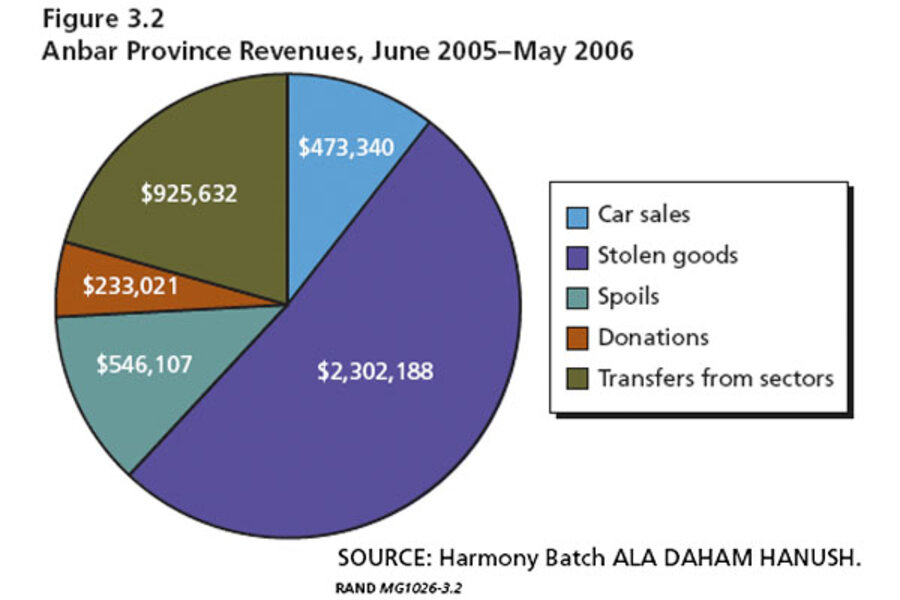The economics of Al-Qaeda in Iraq
Follow the money. From Al Capone to Watergate and beyond, that’s been sound advice for anyone trying to understand the workings of shady organizations. In the latest installment, a group of researchers at the RAND National Defense Research Institute have analyzed accounting ledgers that document the activities of Al-Qaeda in Iraq (AQI) in Anbar province during 2005 and 2006.
In their new report, “An Economic Analysis of the Financial Records of al-Qa’ida in Iraq,” the researchers (Benjamin Bahney, Howard J. Shatz, Carroll Ganier, Renny McPherson, Barbara Sude with Sara Beth Elson, Ghassan Schbley) trace how AQI organized its activities, raised and spent its money, and compensated its members.
For example, they find that during this period, most of AQI’s resources in Anbar came from stolen goods, spoils, and car sales:
From June 2005 to May 2006, AQI’s Anbar administration raised nearly $4.5 million or roughly $373,000 per month (Figure 3.2). AQI in Anbar was financially self-sufficient. This is consistent with the concept of al-Qa‘ida’s franchising strategy as described by [Steve] Kiser (2005), who argued that al-Qa‘ida central provides seed capital to its franchises but pushes them to quickly become financially self-sufficient.
The group obtained more than 50 percent of its revenue from selling what appear to be stolen goods, most of which were highly valuable capital items, such as construction equipment, generators, and electrical cables. In contrast to what has been suggested in much news reporting, the data do not support the claim that the group was largely financed by selling stolen oil, as the revenue garnered from oil appears to be fairly negligible in the context of total group revenues at this level of administration (note that oil revenues are not shown separately in Figure 3.2 but are instead a small portion of the stolen goods entry in the figure). However, it is also entirely possible that oil revenues were garnered by one of the many Anbari AQI sectors that we do not have data on, as well as by the national AQI administration, which had a number of purported ministries and claimed to have a specific “oil minister.”
Another interesting finding: Al-Qaeda’s foot soldiers aren’t in it for the money:
Individual members of AQI made less money than ordinary Anbaris—AQI average annual household compensation was $1,331 compared to $6,177 for average Anbar households—but faced a nearly 50-fold increase in the yearly risk of violent death. AQI compensation included monthly payments for members and their dependents, as well as monthly payments to the families of imprisoned and deceased members. These latter payments constituted a form of insurance unavailable to civilian Anbar households, but still resulted in lower risk-adjusted expected lifetime earnings.
Add/view comments on this post.
------------------------------
The Christian Science Monitor has assembled a diverse group of the best economy-related bloggers out there. Our guest bloggers are not employed or directed by the Monitor and the views expressed are the bloggers' own, as is responsibility for the content of their blogs. To contact us about a blogger, click here. To add or view a comment on a guest blog, please go to the blogger's own site by clicking on the link above.





